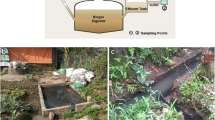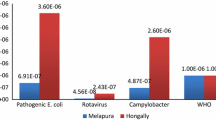Abstract
Wastewater reuse contributes to closing the nutrient recycling loop as a sustainable way of managing water resources. Bangkok has over a thousand man-made drainage and irrigation canals for such purposes. Its use for agricultural and recreational purposes has a long tradition in rural and peri-urban areas. However, the continuation of these practices is increasingly questioned since potential health risks are an issue if such practices are not appropriately managed. The microbial and chemical quality of canal water has considerably deteriorated over the last decade, mainly because of discharged, untreated domestic and industrial wastewater. It is important to understand the health risks of wastewater reuse and identify risky behaviors from the most highly exposed actors promote the safe use of wastewater. This study assessed diarrhea infection risks caused by the use of and contact with wastewater in Klong Luang municipality, a peri-urban setting in Northern Bangkok, using quantitative microbial risk assessment. Wastewater samples were collected from canals, sewers at household level, and vegetables grown in the canals for consumption. Samples were also collected from irrigation water from the agricultural fields. Two protozoa, Giardia lamblia and Entamoeba histolytica, were quantified and analyzed by real-time PCR, exposure assessment was conducted, and finally, the risk of infection due to contact with wastewater in different scenarios was calculated. The results showed that canal water and vegetables were heavily contaminated with G. lamblia and E. histolytica. Infection risk was high in tested scenarios and largely exceeded the acceptable risk given by WHO guidelines.

Similar content being viewed by others
References
Anceno AJ, Katayama H, Houpt ER, Chavalitshewinkoon-Petmitr P, Chuluun B, and Shipin OV (2007a). IMS-free DNA extraction for the PCR-based quantification of Cryptosporidium parvum and Giardia lamblia in surface and waste water. International Journal of Environmental Health Research 17:297-310.
Anceno AJ, Ozaki M, Dang YND, Chuluun B, and Shipin OV (2007b). Canal networks as extended waste stabilization ponds: fate of pathogens in constructed waterways in Pathumthani Province, Thailand. Water Science and Technology 55:143-156.
Arias CA, Cabello A, Brix H, and Johansen NH (2003). Removal of indicator bacteria from municipal wastewater in an experimental two-stage vertical flow constructed wetland system. Water Science and Technology 48:35-41.
Atlas U (2002). Infectious diseases kill 1/3 worldwide; AIDS is top cause of death in developing region. UC Atlas of Global Inequality.
Boone I, Van der Stede Y, Bollaerts K, Vose D, Maes D, Dewulf J, et al. (2009). NUSAP method for evaluating the data quality in a quantitative microbial risk assessment model for Salmonella in the pork production chain. Risk Anal 29:502-517.
Campos C (2008). New perspectives on microbiological water control for wastewater reuse. Desalination 218:34-42.
Conradin K, Kropac M, Spuhler D (2010). The SSWM Toolbox. Basel: seecon international gmbh. http://sswm.info. Accessed 10 March 2011
Covello VT, and Merkhofer MW (1993). Risk Assessment Methods. Plenum Press, New York.
Diallo MBC, Anceno AJ, Tawatsupa B, Houpt ER, Wangsuphachart V, and Shipin OV (2008). Infection risk assessment of diarrhea-related pathogens in a tropical canal network. Science of the Total Environment 407:223-232.
Dietrich JP, Darby JL, and Loge FJ (2009). Potential Health Risks Associated with Particles in Reclaimed Wastewater. Journal of Environmental Engineering-Asce 135:285-290.
Ensink JHJ, Mahmood T, and Dalsgaard A (2007). Wastewater-irrigated vegetables: market handling versus irrigation water quality. Tropical Medicine & International Health 12:2-7.
Furumoto WA, and Mickey R (1967a). A Mathematical Model for Infectivity-Dilution Curve of Tobacco Mosaic Virus - Experimental Tests. Virology 32:224-33.
Furumoto WA, and Mickey R (1967b). A Mathematical Model for Infectivity-Dilution Curve of Tobacco Mosaic Virus - Theoretical Considerations. Virology 32:216-23.
Haas C, and Eisenberg JNS (2001). Risk assessment. Pages 161–183 in L. Petrel and J. Bartram, editors. Water Quality: Guidelines, Standards and Health. IWA Publishing, London.
Haas CN (1983). Estimation of Risk Due to Low-Doses of Microorganisms - a Comparison of Alternative Methodologies. American Journal of Epidemiology 118:573-582.
Haas CR, Rose JB. and Gerba,CP. (1999). Quantitative Microbial Risk Assessment. Wiley, New York, USA.
Haque R, Roy S, Siddique A, Mondal U, Rahman SMM, Mondal D, et al. (2007). Multiplex real-time PCR assay for detection of Entamoeba histolytica, Giardia intestinalis, and Cryptosporidium spp. American Journal of Tropical Medicine and Hygiene 76:713-717.
Huang Y, and Haas CN (2009). Time-Dose-Response Models for Microbial Risk Assessment. Risk Analysis 29:648-661.
Hung T, Yasuoka Y (2008) Remote sensing and GIS to study the sub-urbanization dynamics: a case study in northern Bangkok, Thailand. Sub-urbanization dynamics in Rangsit. www.hbp.usm.my/HBPConference/parallel.pdf. Accessed 25 Feb 2008.
Keraita B, Konradsen F, Drechsel P, and Abaidoo RC (2007). Reducing microbial contamination on wastewater-irrigated lettuce by cessation of irrigation before harvesting. Tropical Medicine & International Health 12:8-14.
Lemarchand K, Masson L, and Brousseau R (2004). Molecular biology and DNA microarray technology for microbial quality monitoring of water. Crit Rev Microbiol 30:145-172.
Mataragas M, Zwietering MH, Skandamis PN, and Drosinos EH (2010). Quantitative microbiological risk assessment as a tool to obtain useful information for risk managers — Specific application to Listeria monocytogenes and ready-to-eat meat products. International Journal of Food Microbiology 141, Suppl1:S170-S179.
Nguyen-Viet H, Zinsstag J, Schertenleib R, Zurbrügg C, Obrist B, Montangero A, et al. (2009). Improving environmental sanitation, health and well-being - a conceptual framework for integral interventions. EcoHealth. 6(2): 180-91.
Pradhan PP, Perara R (2006). Impact of Urbanization on the Water Resources and Public Health. Bangkok: Asian Institute of Technology Publication, pp 87–102.
Rendtorff RC (1954). The Experimental Transmission of Human Intestinal Protozoan Parasites .1. Endamoeba-Coli Cysts Given in Capsules. American Journal of Hygiene 59:196-208.
Seidu R, Heistad A, Amoah P, Drechsel P, Jenssen PD, and Stenstrom TA (2008). Quantification of the health risk associated with wastewater reuse in Accra, Ghana: a contribution toward local guidelines. J Water Health 6:461-471.
Steyn M, Jagals P, and Genthe B (2004). Assessment of microbial infection risks posed by ingestion of water during domestic water use and full-contact recreation in a mid-southern African Region. Water Sci. Technol. 50:301-308.
Surinkul N, and Koottatep T (2009). Advanced Sanitation Planning Tool with Health Risk Assessment: Case study in a peri-urban community in Thailand. Human and Ecological Risk Assessment 15:1-14.
Thai_government (2005). Annual Epidemiological Surveillance, Report 2005.
Westrell T, Schonning C, Stenstrom TA, and Ashbolt NJ (2004). QMRA (quantitative microbial risk assessment) and HACCP (hazard analysis and critical control points) for management of pathogens in wastewater and sewage sludge treatment and reuse. Water Science and Technology 50:23-30.
WHO (2006a). Guidelines for drinking-water quality, third edition, incorporating first addendum. World Health Organization, Geneva.
WHO (2006b). Guidelines for the safe use of wastewater, excreta and greywater World Health Organization, Geneva.
Yajima A, and Koottatep T (2010). Assessment of E. coli and Salmonella spp. infection risks associated with different fecal sludge disposal practices in Thailand. J Water Health 8:355-364.
Zhang LH, Hong S, Wen C, Mao XH, Liu A, Gan FX (2009). A novel combined system for onsite domestic wastewater treatment in rual areas. Environmental Engineering Science 26(4):775-782. doi:10.1089/ees.2008.0099
Acknowledgments
The authors thank Mr. Antoine Morel, Drs. Thammarat Koottatep, Oleg Shipin, Narong Surinkul, Cherif Diallo, Ho Ky Quang Minh, Alfredo Anceno, and Ms. Teamvan Boontawee at the Asian Institute of Technology and Dr Jan Hattendorf and Dr Esther Schelling at Swiss Tropical and Public Health Institute for their help. We thank the Thai National Centre for Genetic Engineering and Biotechnology Central Research Unit (BIOTEC-CRU) for allowing us to use the qPCR machine, as well as Dr Porntip Petmitr (Mahidol University) and Dr Eric R. Houpt (Virginia University) for providing genetic materials of parasites analyzed. This study was supported by the Swiss National Science Foundation (SNSF) and the Swiss Agency for Development and Cooperation (SCD) through the program of the National Center for Competences in Research (NCCR) North–South.
Author information
Authors and Affiliations
Corresponding author
Rights and permissions
About this article
Cite this article
Ferrer, A., Nguyen-Viet, H. & Zinsstag, J. Quantification of Diarrhea Risk Related to Wastewater Contact in Thailand. EcoHealth 9, 49–59 (2012). https://doi.org/10.1007/s10393-012-0746-x
Received:
Revised:
Accepted:
Published:
Issue Date:
DOI: https://doi.org/10.1007/s10393-012-0746-x




